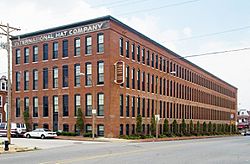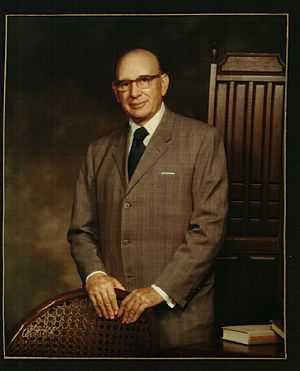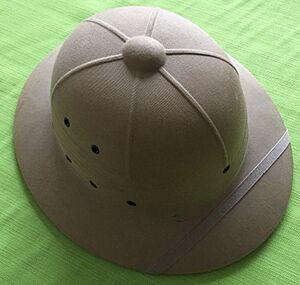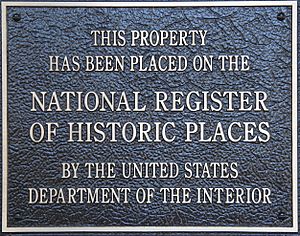International Hat Company facts for kids

Former International Hat warehouse (1954–1976) in Soulard, St. Louis, Missouri. The building was originally built in 1904 by Brown Shoe Company. Since 1980, it has been used as a senior and disabled living facility. The building is listed with the National Register of Historic Places.
|
|
|
Formerly
|
International Harvest Hat Company |
|---|---|
| Private | |
| Industry | Hat apparel |
| Fate | Liquidated |
| Successor | Venture Products, Inc. |
| Founded | August 17, 1917 in St. Louis, Missouri, United States |
| Founder | Isaac Apple |
| Defunct | June 14, 1989 |
| Headquarters | 2528 Texas Avenue,
St. Louis
,
United States
|
|
Number of locations
|
7 factories (1982) |
|
Area served
|
Worldwide |
|
Key people
|
|
| Products | Military sun helmets, Sun hats, dress hats, baseball caps, earmuffs |
|
Number of employees
|
1,500 (1982) |
| Parent | Interco, Inc. (1978–1989) |
| Subsidiaries |
|
The International Hat Company, once called the International Harvest Hat Company, was a big hat and helmet maker. It was based in St. Louis, Missouri, United States. This company was one of the largest hat makers in the U.S. At one point, it was the biggest maker of harvest hats in the world!
Many people remember International Hat for making special military sun helmets. These helmets were worn by soldiers, Marines, and sailors during and after World War II. The company also made many other hats. These included harvest hats, straw hats, fiber sun hats, fancy dress hats, baseball caps, and earmuffs. Today, their military sun helmets are popular items for collectors.
The company started in 1917. At first, it only made harvest straw hats. By the late 1930s, they added fiber sun hats and leather harvest hats. During World War II, International Hat created different military sun helmets. Some even had a basic way to let air in.
After the war, the company started using plastic molding. They moved away from pressed fiber materials. In the 1950s, a part of the company, General Fibre Company, changed its name to General Moulding Company. This showed their new focus on plastic. By the 1960s, International Hat mostly made baseball caps, straw hats, earmuffs, and plastic helmets.
During this time, the company often built factories in small towns. These factories often became the biggest employer in those communities. Sometimes, International Hat even gave land or equipment to help create parks near their factories. These parks were for their employees, their families, and the local community.
After 61 years, the company was sold in 1978 to Interco, Inc.. It kept working as a part of Interco. In 1988, Interco faced a big challenge from another company trying to buy it. Because of this, International Hat was sold off in 1989 to Paramount Cap Company. This was part of a plan to help Interco with its money problems. Interco later went out of business in 1991.
Even though International Hat closed, some of its original factories are still making hats today. They are used by other hat companies in Southeastern Missouri. Also, one of International Hat's old warehouses in Soulard, Missouri, is now a historic building. It is listed on the National Register of Historic Places. International Hat used this building from 1954 to 1976. Today, it is a living facility for seniors and people with disabilities.
Contents
Company History
How the Company Started
Isaac Apple started the company on August 17, 1917. It was first called International Harvest Hat Company. The Apple and Tilles families, who were well-known in St. Louis, started the company during World War I. The Apple family had already started another hat company before this.
The company's first goal was to make harvest straw hats for people to buy. St. Louis was a big center for making hats during the Second Industrial Revolution. By the early 1920s, International Harvest Hat became the world's largest maker of harvest hats. In 1928, the company made over 36,000 hats every day! That's about 9.4 million hats each year.
As cars became popular in the 1930s, fashion started to change. In 1931, the company began making men's straw dress hats to keep up with new styles. In 1938, the company changed its name to International Hat Company. This new name showed that they were making many different types of hats. In 1940, they started making military sun helmets for the U.S. military. Making things for the war became a big part of their work.
When Isaac Apple passed away in 1935, his nephew, George Tilles, Jr., became the company president. Tilles helped the company grow a lot. He expanded their factory from a small 5,000 square feet to a huge 150,000 square feet. Under Tilles, International Hat grew even more during World War II. By 1942, the company had its main factory, several warehouses, and offices in Mexico and New York City. They also brought in goods from many other countries.
Growing and Expanding
After World War II, International Hat Company grew even more. They found new markets, built more factories, and made new products. Frank Pellegrino became president in 1956 and chairman until 1975. He helped the company open a second factory in Oran, Missouri, in 1946. This factory became the biggest employer in that city.
Pellegrino helped International Hat grow to over 1,500 employees. They had six factories in the U.S. During the 1950s and 1960s, International Hat expanded from St. Louis to five other factories in Southeast Missouri. Many of these towns became "one-factory towns" because the company was so important there. They also opened a factory in Texas.
During this time, the company kept making military helmets and straw hats. But they also started making plastic hats and helmets. Plastic was a new and exciting material. It allowed for easier production and lighter hats. In the 1960s, the company started focusing on baseball caps. In the 1970s, they also began selling earmuffs for winter.
Under Pellegrino, the company reached its biggest size and success.
Sale and End of the Company
Jean S. Goodson became president of International Hat in 1971. He started to reduce imports and focus on certain hat types. The company's board decided to sell the company. Frank G. Pellegrino, Sr., who was the son of Frank P. Pellegrino, helped with the sale.
In 1977, Pellegrino started the process to sell the company to Interco, Incorporated. Interco was a large company that owned furniture, clothing, and shoe businesses. On March 31, 1978, the stockholders agreed to the deal. International Hat was officially sold to Interco that day.
International Hat continued to operate as a part of Interco until June 14, 1989. The hat market in the U.S. faced more competition from other countries. Hats from Brazil, Spain, Taiwan, and China were cheaper. By 1989, China sent 6.5 million dozen hats to the U.S. This was 31% of the total hat market! Even though more hats were being sold in the U.S., American companies were selling less of them.
The main reason International Hat closed was because of Interco's own problems. In 1988, another company tried to take over Interco. To stop this, Interco took on a lot of debt to buy back its own stock. They sold off many of their companies, including International Hat, to try and pay off this debt. Even though International Hat was making money, it was sold in 1989 to Paramount Cap Company. Interco later went out of business in 1991.
What Happened Next
The factories in Dexter, Marble Hill, and Oran were reopened in May 1989. They were sold to Paramount Cap Company. The Dexter factory closed in 2000 but reopened in 2001 under Venture Products, Inc. The Oran factory was also sold and is now owned by Venture Products, Inc. Today, the Oran hat plant still makes straw hats.
Products Made
International Hat made many different products over its 83 years. But it is most famous for its military sun helmets. These helmets were made of pressed fiber and given to the U.S. armed forces during World War II. These helmets were used for a very long time in the military. They were even used longer than the M1 steel helmet! This makes the pressed fiber sun helmet one of the longest-used helmets by the U.S. military.
During World War II, International Hat was one of two main companies that made these helmets for the U.S. military. The other was Hawley Products Company. Together, they made over 100,000 sun helmets for soldiers fighting in Europe and the Pacific.
The United States Marine Corps used the International Hat sun helmet for combat and training. Marines called it the "elephant hat." It was first given to the 1st Marine Division in 1941. Today, this helmet is still used by Marine Corps marksmanship range coaches.
Even though the International Hat sun helmet was designed before the M1 steel helmet, it was used for many more decades. It was used in the Korean War and Vietnam War. By the time of the Gulf War, only some people in the U.S. Navy still used the pressed fiber sun helmet.
Military records show how many helmets were made and when. For example, the U.S. Army ordered 38,423 International Hat helmets for World War II and after.
| Product Number | Type of Product | Order Date | Quantity Sold |
|---|---|---|---|
| Army W-699 | Fiber Military Helmet | February 10, 1942 | 15,878 |
| Army PO | Fiber Military Helmet | May 1942 | 10,989 |
| Army W-30 | Fiber Military Helmet | 1946 | 11,875 |
Helping the Community
International Hat also did good things for the community. The most notable was creating two public parks. After his business partner, George Tilles Jr., passed away, President Pellegrino gave land and money to build a park in Oran. It was named the George Tilles Jr. Memorial Park.
In 1968, Pellegrino also started a new park in Marble Hill, MO. This park, called Maria Pellegrino Park, was named after Pellegrino's mother. It opened on June 2, 1972. International Hat directly gave money to build a large shelter at Pellegrino Park.
The company also donated hats to volunteer groups. In 1981, International Hat gave 4,764 hats to the national meeting of the Girls Scouts of America. In 1989, they made 200 special women's hats for a convention in Marble Hill.
Company Legacy
The military fiber sun helmets made by International Hat have become popular collector's items. This is especially true for the Marine helmets, which have the USMC symbol on the front. These helmets are sought after by people who collect military items and World War II memorabilia.
Company Locations
International Hat had many locations both in the U.S. and other countries. At its largest, it had seven factories in the U.S., several warehouses, and offices for buying and selling goods.
One important location is the International Hat Company warehouse in the Soulard neighborhood of St. Louis. This building is historically important. It was added to the National Register of Historic Places on October 20, 1980. The building was built in 1904 by a famous architect named Albert B. Groves. It was first a factory for the Brown Shoe Company. In 1954, International Hat Company turned it into a warehouse and used it until 1976.
The first International Hat headquarters in 1917 was at 711 Lucas Avenue. From 1917 to 1928, this factory made straw harvest hats. By the 1920s, it was the biggest maker of harvest hats in the world. In 1928, the company bought a new building at 2528 Texas Avenue. This new location continued to make straw harvest hats and all the military sun helmets during and after World War II. This large building had five floors and was about two acres in size.
In 2016, this former factory building was bought by two non-profit groups. They created a new organization called Brick City Makes. This group helps new manufacturing businesses get started. It's the first non-profit in the U.S. to turn an old industrial building into a place where new manufacturers can rent space and get support.
Most of International Hat's factories were in Missouri. The other factories in Missouri were in Chaffee, Dexter, Marble Hill, Piedmont, and Oran. The Oran factory was built in 1946 and expanded later. It closed in 1984. The Chaffee plant opened in 1980 but closed in 1981. The Marble Hill factory was expanded in 1972 and employed about 300 workers. The Dexter factory opened in 1959 and operated for 30 years before closing in 1989.
Company Presidents
- Isaac Apple (1917–1935)
- George Tilles, Jr. (1935–1956)
- Frank P. Pellegrino (1956–1971)
- Jean S. Goodson (1971–1978)







